Unit 4 Body language
文档属性
| 名称 | Unit 4 Body language |  | |
| 格式 | zip | ||
| 文件大小 | 291.5KB | ||
| 资源类型 | 教案 | ||
| 版本资源 | 人教版(新课程标准) | ||
| 科目 | 英语 | ||
| 更新时间 | 2013-06-20 23:05:58 | ||
图片预览

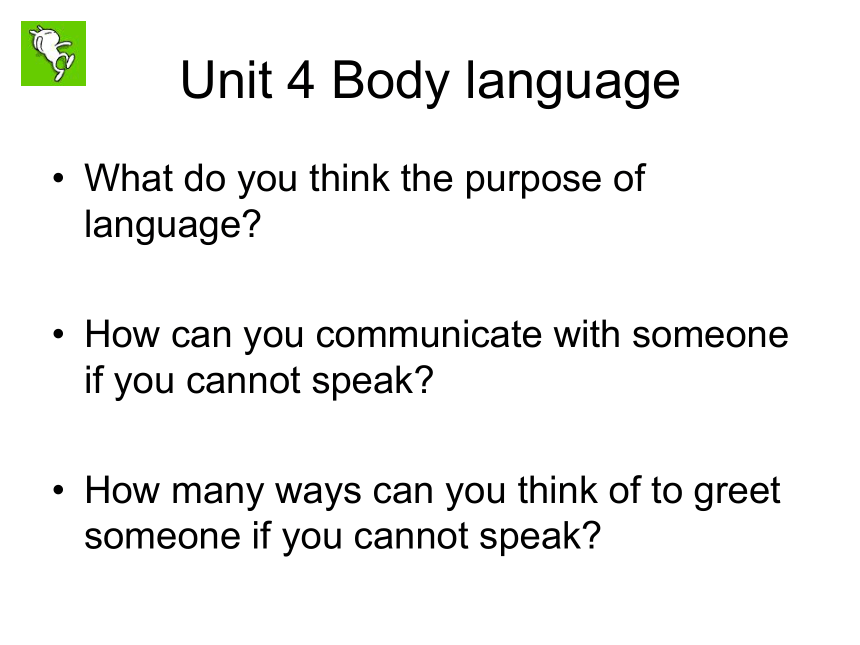
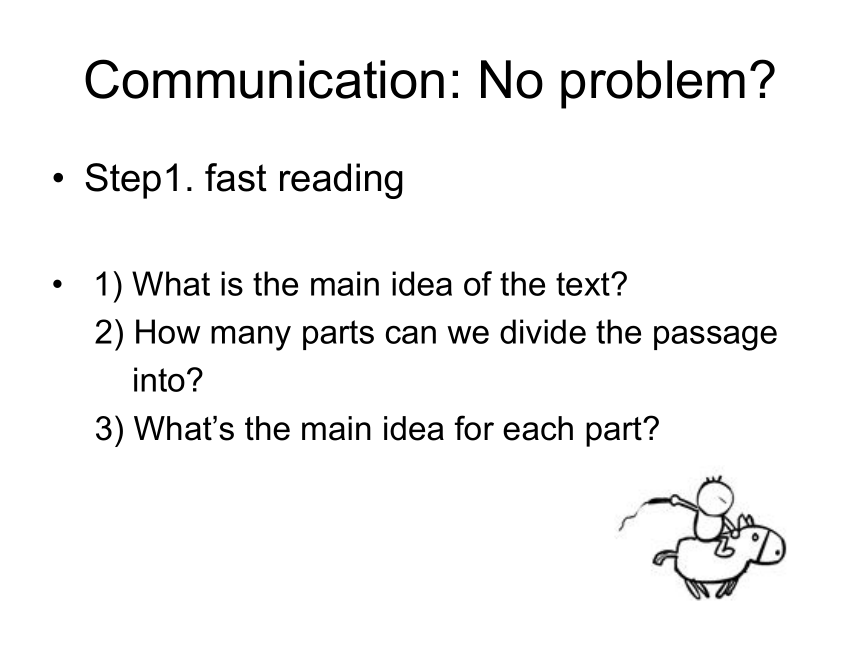
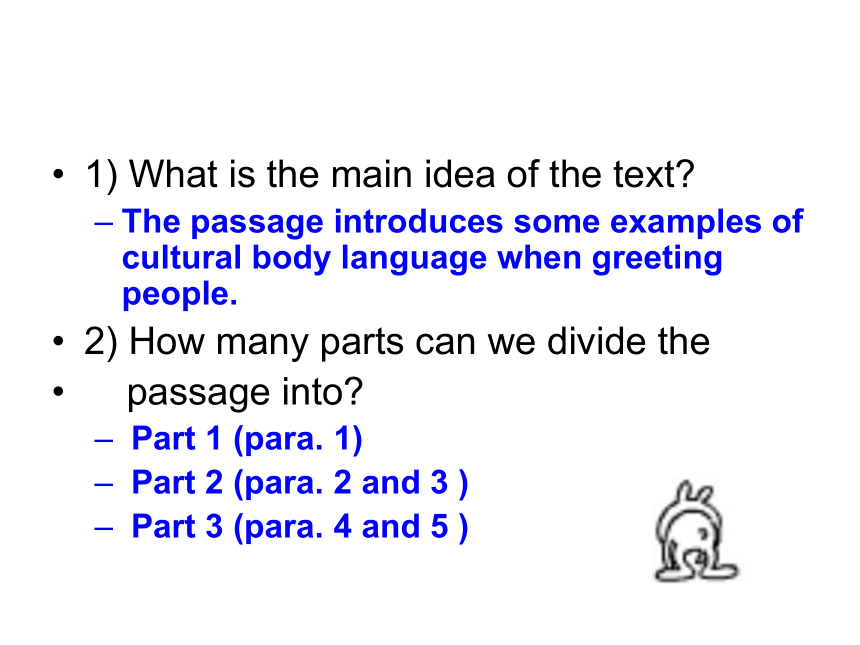

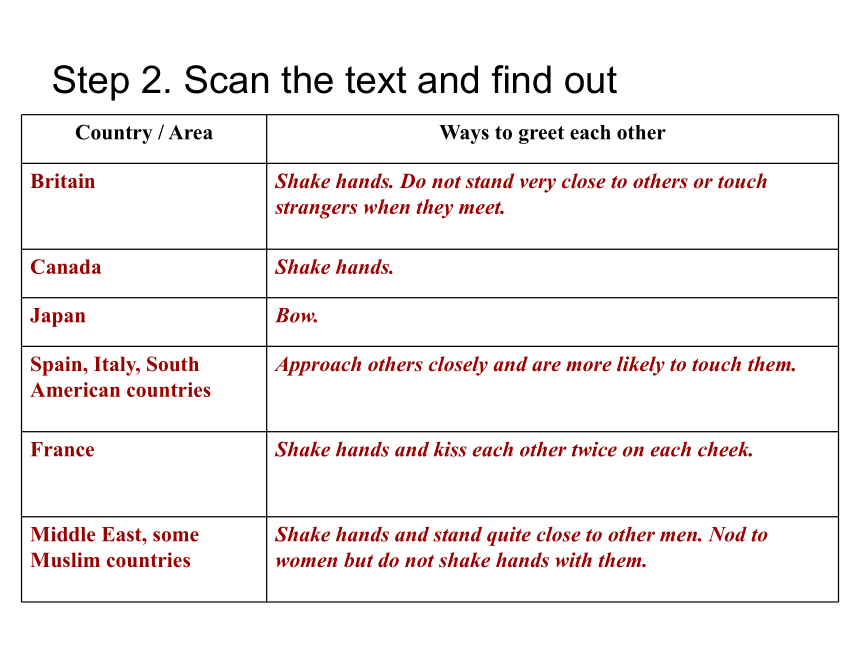
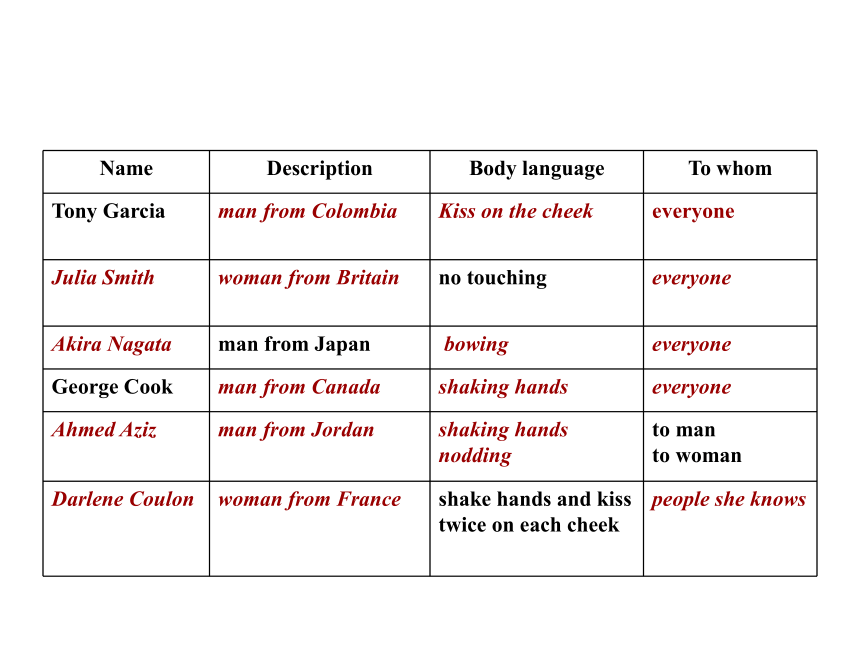
文档简介
课件17张PPT。Unit 4 Body languageWhat do you think the purpose of language?
How can you communicate with someone if you cannot speak?
How many ways can you think of to greet someone if you cannot speak?Communication: No problem?Step1. fast reading
1) What is the main idea of the text?
2) How many parts can we divide the passage
into?
3) What’s the main idea for each part?
1) What is the main idea of the text?
The passage introduces some examples of cultural body language when greeting people.
2) How many parts can we divide the
passage into?
Part 1 (para. 1)
Part 2 (para. 2 and 3 )
Part 3 (para. 4 and 5 )
3) What’s the main idea for each part? Step 2. Scan the text and find outStep 3. use the passage to help you answer the following questions1) Is the author of this passage male or female? How do you know?
The author is male. Ahmed Aziz will not shake hands with women, but he shakes hands with the author.
2) What were the two mistakes that the author noticed?
He noticed that the Colombian man kissed the British woman, but in her culture, a kiss from a stranger is not expected. He also noticed that the Japanese man bowed just as the Canadian man started to shake hands, so one man’s nose touched the other man’s hand.
3) Who seemed to prefer to keep more physical diastance from others? Who seemed to prefer closer physical distance ?
The British woman, Julia and probably the Canadian man, George, seemed to prefer to keep more physicaldistance from others. The Colombian man, Tony, and the Jordanian man Ahmed, seemed to prefer closer physical distance.
4) Did any students have similar greeting customs? If so, which one?
Yes. Tony from Colombia and Darlene from France had a similar greeting custom — a kiss. George from Canada and Ahmed from Jordan also had a similar greeting custom — a handshake, but Ahmed shakes hands only with men.
5) “When in Rome, do as the Romans do.” What do you think this famous saying means?
This saying means that when we are in a certain place, we should follow the customs of the people who live in that place, not our own customs.
6) Do you agree with the author’s statement that body language is not good or bad? Why or why not?
Step 4. summaryStep 5. translation The first person to arrive was Tony Garcia, closely followed by Julia Smith from Britain. 2. Not all cultures greet each other the same way, nor are they comfortable in the same way with touching or distance between people.
3. However, people from places like Spain, Italy or South American countries approach others closely and are more likely to touch them.
Step 5. homework Complete p.27 Exercise 3
How can you communicate with someone if you cannot speak?
How many ways can you think of to greet someone if you cannot speak?Communication: No problem?Step1. fast reading
1) What is the main idea of the text?
2) How many parts can we divide the passage
into?
3) What’s the main idea for each part?
1) What is the main idea of the text?
The passage introduces some examples of cultural body language when greeting people.
2) How many parts can we divide the
passage into?
Part 1 (para. 1)
Part 2 (para. 2 and 3 )
Part 3 (para. 4 and 5 )
3) What’s the main idea for each part? Step 2. Scan the text and find outStep 3. use the passage to help you answer the following questions1) Is the author of this passage male or female? How do you know?
The author is male. Ahmed Aziz will not shake hands with women, but he shakes hands with the author.
2) What were the two mistakes that the author noticed?
He noticed that the Colombian man kissed the British woman, but in her culture, a kiss from a stranger is not expected. He also noticed that the Japanese man bowed just as the Canadian man started to shake hands, so one man’s nose touched the other man’s hand.
3) Who seemed to prefer to keep more physical diastance from others? Who seemed to prefer closer physical distance ?
The British woman, Julia and probably the Canadian man, George, seemed to prefer to keep more physicaldistance from others. The Colombian man, Tony, and the Jordanian man Ahmed, seemed to prefer closer physical distance.
4) Did any students have similar greeting customs? If so, which one?
Yes. Tony from Colombia and Darlene from France had a similar greeting custom — a kiss. George from Canada and Ahmed from Jordan also had a similar greeting custom — a handshake, but Ahmed shakes hands only with men.
5) “When in Rome, do as the Romans do.” What do you think this famous saying means?
This saying means that when we are in a certain place, we should follow the customs of the people who live in that place, not our own customs.
6) Do you agree with the author’s statement that body language is not good or bad? Why or why not?
Step 4. summaryStep 5. translation The first person to arrive was Tony Garcia, closely followed by Julia Smith from Britain. 2. Not all cultures greet each other the same way, nor are they comfortable in the same way with touching or distance between people.
3. However, people from places like Spain, Italy or South American countries approach others closely and are more likely to touch them.
Step 5. homework Complete p.27 Exercise 3
同课章节目录
